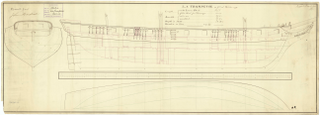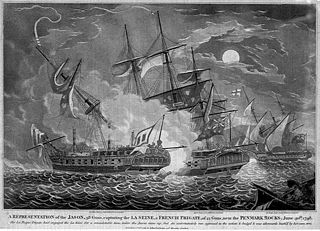
HMS Hannibal was a 74-gun third-rate ship of the line of the Royal Navy, launched on 15 April 1786, named after the Carthaginian general Hannibal. She is best known for having taken part in the Algeciras Campaign, and for having run aground during the First Battle of Algeciras on 5 July 1801, which resulted in her capture. She then served in the French Navy until she was broken up in 1824.

Minerve was a 40-gun Minerve-class frigate of the French Navy. The British captured her twice and the French recaptured her once. She therefore served under four names before being broken up in 1814:

HMS Majestic was a 74-gun third-rate ship of the line launched on 11 December 1785 at Deptford. She fought at the Battle of the Nile, where she engaged the French ships Tonnant and Heureux, helping to force their surrenders. She was captained by George Blagdon Westcott, who was killed in the battle.

HMS Trompeuse was the French privateer Mercure, captured in 1799. She foundered in the English Channel in 1800.

HMS Jason was a 38-gun Artois-class fifth-rate frigate of the Royal Navy. She served during the French Revolutionary Wars, but her career came to an end after just four years in service when she struck an uncharted rock off Brest and sank on 13 October 1798. She had already had an eventful career, and was involved in several engagements with French vessels.

HMS Carysfort was a 28-gun Coventry-class sixth-rate frigate of the Royal Navy. She served during the American War of Independence, the French Revolutionary and the Napoleonic Wars in a career that spanned over forty years.

HMS Santa Dorothea was a Royal Navy 34-gun fifth rate. This frigate had previously served in the Spanish Navy under the name Santa Dorotea. Built in Spain in 1775, she served during the early years of the French Revolutionary Wars until being captured while sailing as part of a squadron off Cartagena. Taken into British service, she spent the rest of the French Revolutionary and most of the Napoleonic Wars under the white ensign, until being broken up in 1814.
HMS Abergavenny was originally Earl of Abergavenny, an East Indiaman sailing for the British East India Company (EIC). As an East Indiaman she made two trips to China between 1790 and 1794. The Royal Navy bought her in 1795, converted her to a 56-gun fourth-rate ship of the line, and renamed her. One year later the East India Company built a new and much larger ship which was also named the Earl of Abergavenny and which sank off Weymouth Bay in 1805. HMS Abergavenny was sold for breaking in 1807.
HMS Alcmene was a 32-gun Alcmene-class fifth rate of the Royal Navy. This frigate served during the French Revolutionary and Napoleonic Wars under the command of several notable officers. Alcmene was active in several theatres of the war, spending most of her time cruising in search of enemy vessels or privateers, and escorting convoys. She fought at the Battle of Copenhagen in 1801 and served in the blockade of the French coasts during the later Napoleonic Wars until she was wrecked on the French coast in 1809.
HMS Drake was a 14-gun brig-sloop of the Royal Navy. She was bought from a commercial builder during the early years of the American War of Independence, and went on to support operations in the English Channel and the Caribbean. At one stage she assisted an attack on a French-held island, an expedition commanded by a young Horatio Nelson. Laid up for a time after the end of the American War of Independence, she returned to service shortly before the outbreak of the French Revolutionary Wars. Drake spent most of her time in Caribbean waters, until being declared unfit for service in 1800 and deleted from the navy lists.

HMS Arab was a 22-gun post ship of the Royal Navy. She was formerly the 18-gun French privateer Brave, which the British captured in 1798. She served during the French Revolutionary and Napoleonic Wars until she was sold in 1810.

L'Espoir was a French brig-sloop that served for 9½ years in the French Navy before HMS Thalia captured her in September 1797. In her subsequent short career in British service as HMS Espoir she captured three prizes, with the capture in 1798 of the more heavily armed Genoese pirate Liguria earning her crew a clasp to the Naval General Service Medal. Espoir was laid up in 1799 and sold in 1804.
HMS Mermaid was a gunvessel purchased in Honduras in 1798 for local use. She was sloop-rigged, armed with one long 9-pounder gun and had a crew of 25 men from the "Colonial Troops".
HMS Teazer was a schooner purchased in Honduras in 1798 for local use. She was armed with six 4-pounder guns and had a crew of 25 men from the "Colonial Troops".
HMS Tickler was a gunvessel purchased in Honduras for local use. She was a sloop armed with one 18-pounder gun and had a crew of 25 men. Like Towzer, she was under the command of a merchant captain, in Tickler's case a Mr. Hosmer, who brought with him some of his crew.
HMS Swinger was a schooner purchased in Honduras in 1798 for local use. She had a crew of 25 men from the "Colonial Troops".
HMS Zenobia was a schooner of the Adonis class of the Royal Navy during the Napoleonic War. She was built and completed at Bermuda using Bermuda cedar in 1806 and commissioned under Lieutenant Archibald Hamilton. She sailed for Norfolk, Virginia, on 22 October 1806.
HMS Spencer was a 16-gun brig-sloop of the Royal Navy, formerly the civilian Sir Charles Grey. The Admiralty purchased her in 1795, after having hired her in 1793-94, and renamed her HMS Lilly in 1800. The French privateer Dame Ambert captured her in 1804 and Lilly became the French privateer Général Ernouf. She blew up in 1805 while in an engagement with HMS Renard.
HMS Matilda was the French privateer Matilde, which HMS Cambrian captured in 1805. The British Royal Navy used her briefly that year. She is last listed in 1805.
HMS George was a sloop that the Royal Navy acquired in 1796, probably as the purchase of a prize. Two Spanish privateers of superior force captured her on 3 January 1798 in a sanguinary engagement.